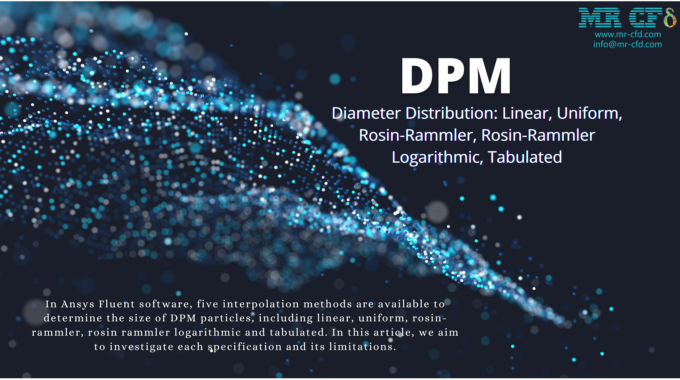
Discrete Phase Model (DPM): Diameter Distribution
Introduction to DPM Diameter Distribution
In Ansys Fluent software, five interpolation methods are available to determine the size of DPM particles, including linear, uniform, rosin-rammler, rosin rammler logarithmic and tabulated. In this article, we aim to investigate each specification and its limitations.
Linear Diameter Distribution
This model can only be used with group injection type. First, we determine the diameter of the starting and ending point. If both points have the same diameter value, the diameter distributions will be the same for all particles. However, if these two points have different values, the diameter distributions will change linearly.
 Uniform Diameter Distribution
Uniform Diameter Distribution
This model can be used with surface and volume injections only. Although assuming a single diameter for all particles is not correct, with a simple simplification assumption, it is employed in most engineering projects. It assumes all drops with the same initial diameter.
Rosin-Rammler Diameter Distribution
A good representation of the droplet size distribution is the expression Rosin-Rammler. The full range of sizes divides into a sufficient number of discrete distances. Each represents an average diameter for which the path calculations perform. We calculate the mass fraction using the following expression:
Where n is the size distribution parameter presented as the spread parameter, and d ̅ is the size constant.
If the diameter distribution is between 0 and 200, The mass fraction expresses as follows:
The total mass fraction is equal to 1 or 100%.
Also, according to the diagram below obtained from solving the Rosin Rammler equation, we see that it has good accuracy according to the experimental data:
The figure below shows the Rosin-Rammler input data:
Rosin Rammler Logarithmic
This method solves the Rosin Rammler Diameter Distribution logarithmically, which increases the accuracy of the problem and, consequently, the computational cost.
Tabulated
This model is only used with cone and surface injection types. You need to use a text file in which diameter distributions are sorted in a tabular form. Three parameters should be set: representative particle size, number fraction and mass fraction.










Comments (0)